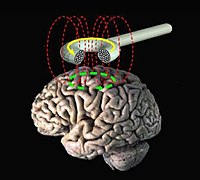
Photo from wikipedia
Abstract Heat-resistant austenitic stainless steels have become the principal alloys for use in steam reformer tubes in the petrochemical industry due to its mechanical properties. These tubes are typically exposed… Click to show full abstract
Abstract Heat-resistant austenitic stainless steels have become the principal alloys for use in steam reformer tubes in the petrochemical industry due to its mechanical properties. These tubes are typically exposed to severe operational conditions leading to microstructural transformations such as the aging phenomenon. The combination of high temperatures and moderate stresses causes creep damages, being necessary to monitor its structural condition by non-destructive techniques. The tube external wall is also subjected to oxidizing atmospheres, favoring the formation of an external surface, composed by an oxide scale and a chromium depleted zone. This external surface is usually not taken into account in the tube evaluation, which can lead to erroneous estimations of the service life of these components. In order to observe the magnetic influence of this layer, two samples, exposed to different operational temperatures, were characterized by non-destructive eddy current testing (ECT), scanning DC-susceptometer and magnetic force microscopy (MFM). It was found that the external surface thickness influences directly in the magnetic response of the samples.
Journal Title: Journal of Magnetism and Magnetic Materials
Year Published: 2018
Link to full text (if available)
Share on Social Media: Sign Up to like & get
recommendations!